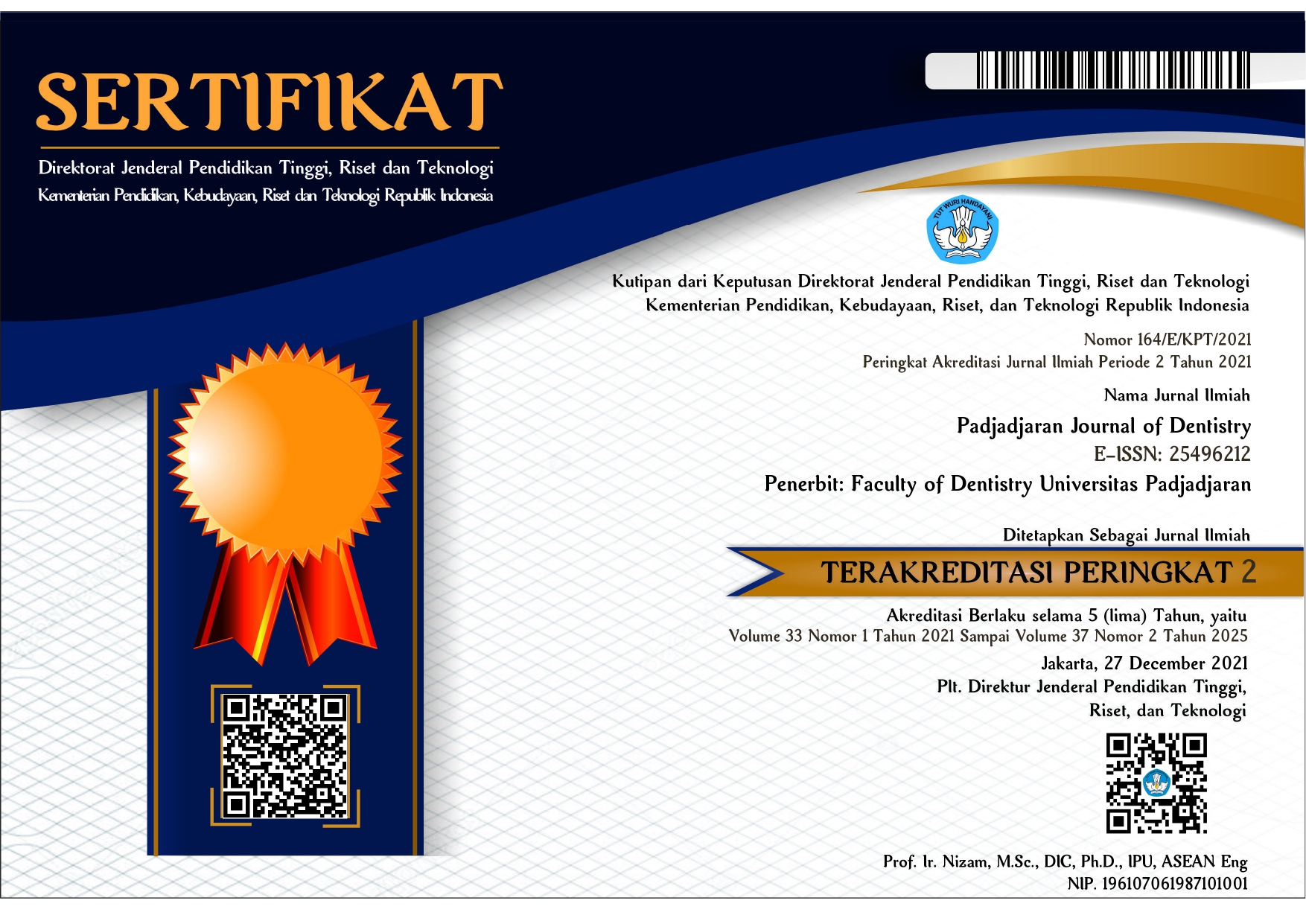Antisense oligonucleotide p45Skp-2 suppresses migratory chemotactic and metastasis of oral malignant Burkitt’s lymphoma cell through down-regulation of MTA-1 and induction of E-cadherin mechanism
Abstract
Introduction: Burkitt’s lymphoma is a high-grade B-cell neoplasm and one of the most aggressive malignancies of lymphoid origins which found mainly in the paediatric population. The treatment options of this tumour are still limited. However, a new strategy for refractory tumour, phosphorothioate oligonucleotide antisense technique has watched with keen interest. This study was aimed to examine the effect of antisense p45Skp-2 (Skp-2 AS) suppressed migratory chemotactic and metastasis of oral malignant Burkitt’s lymphoma (Raji) cell through down-regulation of MTA-1 and E-cadherin. Methods: True experiment laboratory with post-test control group design was confirmed in this study. The efficiency of Skp-2 AS in the suppression of cell chemotactic migration was examined by Boyden chamber assay. To evaluate the inhibition of cell metastasis was conducted by decreasing MTA-1 expression protein. The expressions of MTA-1, E-cadherin and α-tubulin protein were investigated by Western blot analysis. Results: The results revealed that the number of chemotactic migration of Skp-2 AS treated Raji cell was significantly decreased when compared with that of sense p45Skp-2 (Skp-2 S) and scrambled control (SC) cells (P<0.05) followed by decreased expressions of MTA-1 protein and overexpression of E-cadherin. Interestingly, the expression of α-tubulin protein as an internal control was approximately similar in each transfectant cells. Conclusion: p45Skp-2 have an antitumor activity via suppression of migratory chemotactic activity and metastasis on oral Burkitt’s lymphoma cells through down-regulation of MTA-1 and induction of E-cadherin proteins targeting this molecule could represent a promising new therapeutic approach for this type of cancer.
Keywords
Full Text:
PDFReferences
Pavlides SC, Huang KT, Reid DA, Wu L, Blank SV, Mittal K, et al. Inhibitors of SCF-Skp2/Cks1 E3 ligase block estrogen-induced growth stimulation and degradation of nuclear p27kip1: Therapeutic potential for endometrial cancer. Endocrinology. 2013; 154(11): 4030-45. DOI: 10.1210/en.2013-1757
Su J, Zhou X, Wang L, Yin X, Wang Z. Curcumin inhibits cell growth and invasion and induces apoptosis through down-regulation of Skp2 in pancreatic cancer cells. Am J Cancer Res. 2016; 6(9): 1949-62.
Supriatno, Medawati A, Yuletnawati SE. Expression of non-metastatic protein-23 and metastatic associated protein-1 as a molecular target therapy of an oral malignant Burkitt’s lymphoma induced by oligonucleotide p27 sense. J Int Dent Med Res. 2020; 13(2): 503-7.
Suzuki S, Ohashi N, Kitagawa M. Roles of the Skp2/p27 axis in the progression of chronic nephropathy. Cell Mol Life Sci. 2013; 70(18): 3277–87. DOI: 10.1007/s00018-012-1232-x
Zhou W, Srinivasan S, Nawaz Z, Slingerland JM. ERα, SKP2 and E2F-1 form a feed forward loop driving late ERα targets and G1 cell cycle progression. Oncogene. 2014; 33(18): 2341–53. DOI: 10.1038/onc.2013.197
Supriatno, Yuletnawati SE. Up-regulation of S-phase kinase associated protein-2 antisense induces cell growth and migration chemotactic suppression and apoptosisin a malignant oral Burkitt’s lymphoma cells. Int J Sci Res. 2015; 4(12): 1639-44.
Bochis OV, Irimie A, Pichler M, Neagoe IB. The role of Skp2 and its substrate CDKN1B (p27) in colorectal cancer. J Gastrointestin Liver Dis. 2015; 24(2): 225-34. DOI: 10.15403/jgld.2014.1121.242.skp2
Qiu L, Jiabao LV, Chen Y, Wang J, Wu R. Expression of Skp2 and p27kip1 proteins in hypopharyngeal squamous cell carcinoma and its clinical significance. Oncol Lett. 2015; 10(6): 3756-60. DOI: 10.3892/ol.2015.3799
Wen Y, Wang K, Yang K. Inhibiting the role of Skp2 suppresses cell proliferation and tumorigenesis of human gastric cancer cells via the upregulation of p27kip1. Mol Med Rep. 2016; 14(4): 3917-24. DOI: 10.3892/mmr.2016.5676
Linch DC. Burkitt lymphoma in adults. Br J Haematol. 2012; 156(6): 693-703. DOI: 10.1111/j.1365-2141.2011.08877.x
Molyneux EM, Rochford R, Griffin B, Newton R, Jackson G, Menon G, et al. Burkitt’s lymphoma. Lancet. 2012; 379(9822): 1234-44. DOI: 10.1016/S0140-6736(11)61177-X
Salamon D, Adori M, He M, Bonelt P, Severinson E, Kis LL, et al. Type I interferons directly down-regulate BCL-6 in primary and transformed germinal center B cells: Differential regulation in B cell lines derived from endemic or sporadic Burkitt’s lymphoma. Cytokine. 2012; 57(3): 360-71. DOI: 10.1016/j.cyto.2011.12.001
Roberts TC, Langer R, Wood MJA. Advances in oligonucleotide drug delivery. Nat Rev Drug Discov. 2020; 19(10): 673-94. DOI: 10.1038/s41573-020-0075-7
Supriatno, Yuletnawati SE. Up-regulation of S-phase kinase associated protein-2 antisense induces cell growth and migration chemotactic suppression and apoptosis in a malignant oral Burkitt’s lymphoma cells. Int J Sci Res. 2015, 4(12): 1639-44.
Guo S, Booten SL, Watt A, Alvarado L, Freier SM, Teckman JH, et al. Using antisense technology to develop a novel therapy for α-1 antitrypsin deficient (AATD) liver disease and to model AATD lung disease. Rare Dis. 2014; 2: e28511. DOI: 10.4161/rdis.28511
Evers MM, Toonen LJA, van Roon-Mom WMC. Antisense oligonucleotides in therapy for neurodegenerative disorders. Adv Drug Deliv Rev. 2015; 87:90-103
Supriatno. S-Phase kinase-associated protein-2 and nuclear factor-kappa beta as molecular targets of oral Burkitt’s lymphoma cell induced by quinolinone derivate-vesnarinone. Curr Signal Transduction Ther. 2018. 13: 1-6. DOI: 10.2174/1574362413666180912113856
Sen N, Gui B, Kumar R. Role of MTA-1 in cancer progression and metastasis. Cancer Metastasis Rev. 2014; 33(4): 879-89. DOI: 10.1007/s10555-014-9515-3
Yao Y, Feng S, Xiao M, Li Y, Yang L, Gong J. MTA-1 promotes proliferation and invasion in human gastric cancer cells. Onco Targets Ther 2015; 8: 1785-94.
Okugawa Y, Mohri Y, Tanaka K, Kawamura M, Saigusa S, Toiyama Y, et al. Metastasis-associated protein is a predictive biomarker for metastasis and recurrence in gastric cancer. Oncol Rep. 2016; 36(4): 1893-900. DOI: 10.3892/or.2016.5054
Li SH, Tian H, Yue WM, Li L, Li WJ, Chen ZT. Overexpression of metastasis-associated protein 1 is significantly correlated with tumor angiogenesis and poor survival in patients with early-stage non-small cell lung cancer. Ann Surg Oncol. 2011; 18(7): 2048-56. DOI: 10.1245/s10434-010-1510-5
Petrova YI, Schecterson L, Gumbiner BM. Roles for E-cadherin cell surface regulation in cancer. Mol Biol Cell. 2016; 27(21): 3233–44. DOI: 10.1091/mbc.E16-01-0058
Sun Z, Liu G, Xu N. Does hypermethylation of CpG island in the promoter region of the E-cadherin gene increase the risk of lung cancer? A meta-analysis. Thorac Cancer. 2019; 10(1): 54-59. DOI: 10.1111/1759-7714.12900
DOI: https://doi.org/10.24198/pjd.vol32no3.21756
Refbacks
- There are currently no refbacks.
Visitor Stat

Padjadjaran Journal of Dentistry is licensed under Creative Commons Attribution 4.0 International License






.png)

















